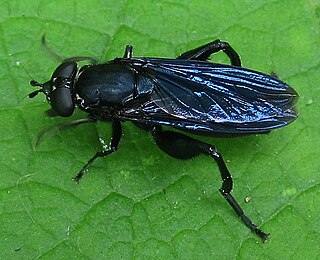
The Micropezidae are a moderate-sized family of acalyptrate muscoid flies in the insect order Diptera, comprising about 500 species in about 50 genera and five subfamilies worldwide,. They are most diverse in tropical and subtropical habitats, especially in the Neotropical Region.

Dasysyrphus venustus is a Holarctic species of hoverfly.

Platycheirus is a large genus of hoverflies. They are also called sedgesitters.

Chalcosyrphus is a genus of hoverflies in the subfamily Eristalinae. Many species exhibit some degree of mimicry of various sawflies and other hymenopterans and are often brightly coloured or metallic in hue. The adults are similar in structure and behavior to the related genus Xylota but differ in larval morphology. They can be found throughout Europe, Asia, North America and South America and seem to prefer damper, boggy habitats. The larvae are saproxylic feeders in rotten wood in these habitats.

Orthonevra is a genus of hoverflies.
Argentinomyia is a small genus of hoverflies.

The Brachyopini is a tribe of hoverflies. Unlike many members of this family these flies are generally darker and less colourful though some genera contain species with an attractive metallic lustre e.g. Chrysogaster. Some like Brachyopa are associated with sap runs where their larvae feed on decaying sap. Others are found in boggy areas where their often semiaquatic larvae feed on decaying organic matter.
Chromocheilosia is a genus of South American hoverflies.

The Milesiini is a large and diverse tribe of hoverflies. They mimic wasps or hornets.

Allobaccha is a genus of hoverfly with a large number of species. It was originally created as a subgenus of Baccha. Many species have an elongated wasp like abdomen and adults as well as larvae are predators of soft-bodied Hemiptera.
Hemixylota is a genus of hoverflies in the family Syrphidae.
Hemixylota incerta is a species of hoverfly in the family Syrphidae.
Hemixylota unicolor is a species of hoverfly in the family Syrphidae.
Hemixylota varipes is a species of hoverfly in the family Syrphidae.
Odyneromyia is a genus of hoverflies in the family Syrphidae.
Odyneromyia valdiviformis is a species of hoverfly in the family Syrphidae.
Sterphus is a genus of hoverflies.
Valdiviomyia is a genus of hoverflies from the family Syrphidae, in the order Diptera.
Valdiviomyia edwardsi is a species of Hoverfly in the family Syrphidae.
Chamaesphegina argentifacies is a species of Hoverfly in the family Syrphidae.







